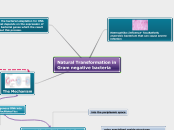Natural Transformation in Gram negative bacteria

Haemophilus Influenza- facultatively anaerobic bacterium that can cause severe infection
Definition: the bacterial adaptation for DNA transfer that depends on the expression of numerous bacterial genes which the result will carry out this process.

The Mechanism
DNA uptake during bacterial transformation
generate single strand of nucleotide that can be added to the bacterial DNA.
transport of foreign DNA from dead cell across the outer membrane:
into the periplasmic space
using specialized vesicle structures (transformasomes)
ssDNA may pass through the membrane, one strand is therefore degraded by nucleases in the process on the external surface of the cell
the DNA may or may not be cleaved by the bacterial cell restriction enzyme, generating double strand breaks
the DNA uptake sequences identified is 5' AAGTGCGGT 3'
the translocated single-stranded DNA may then be integrated into the bacterial chromosomes by a RecA-dependent process
RecA protein binds strongly to ssDNA to form a nucleoprotein filament. The protein has more than one DNA binding site, and thus can hold a single strand and double strand together.
catalyze a DNA synapsis reaction between a DNA double helix and a complementary region of single stranded DNA
